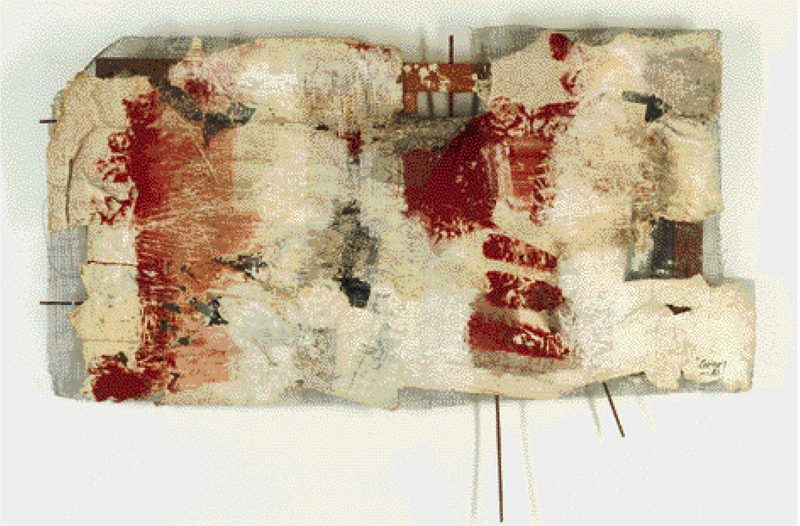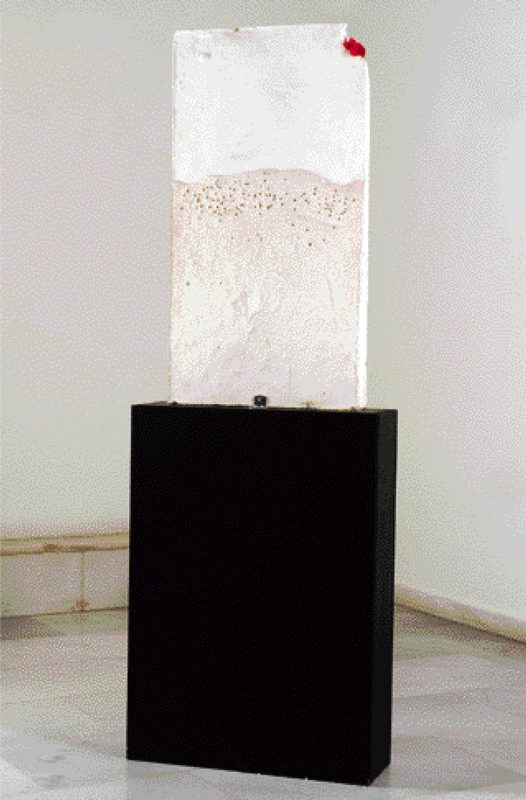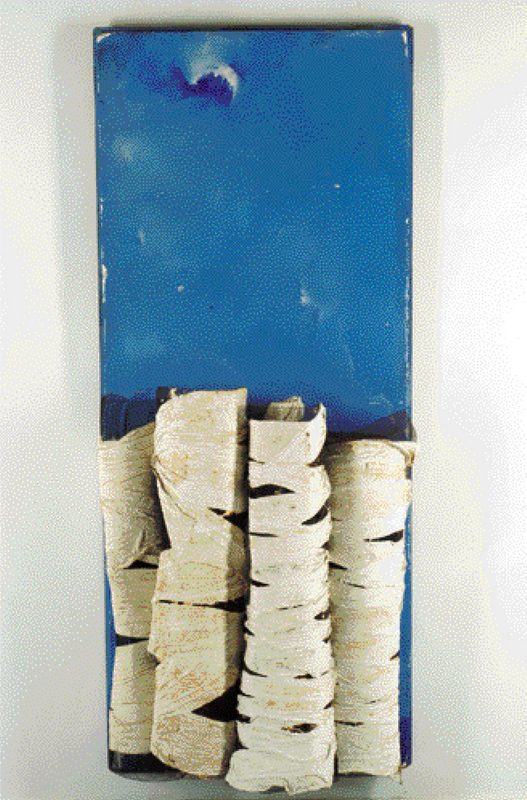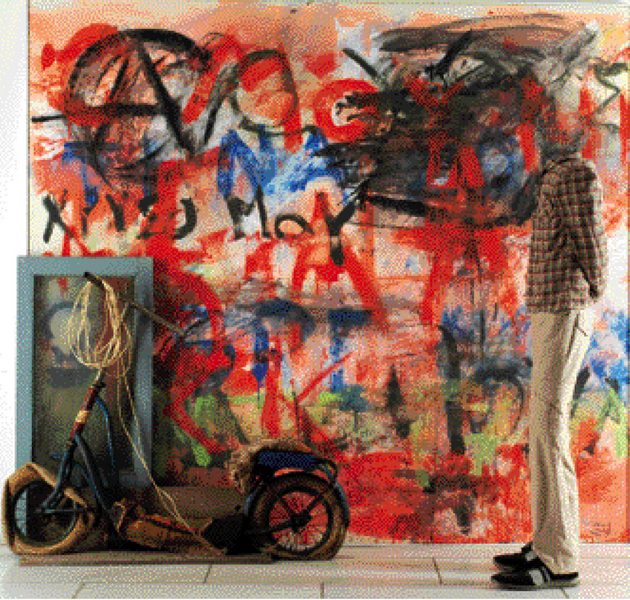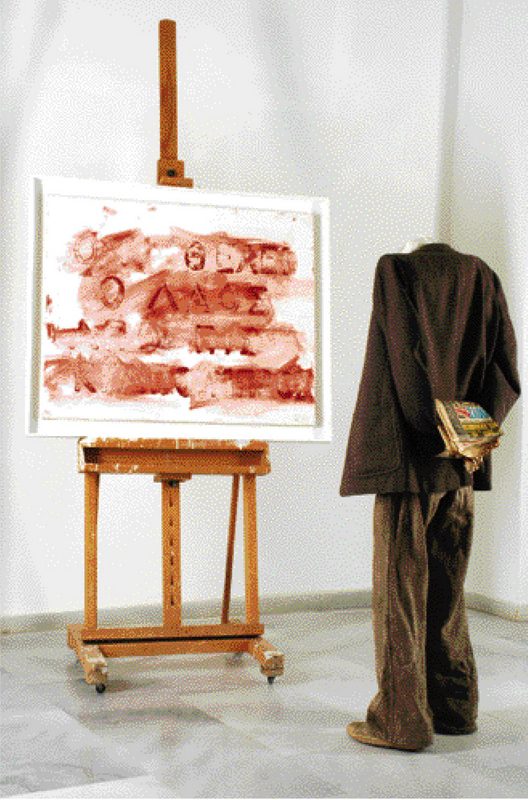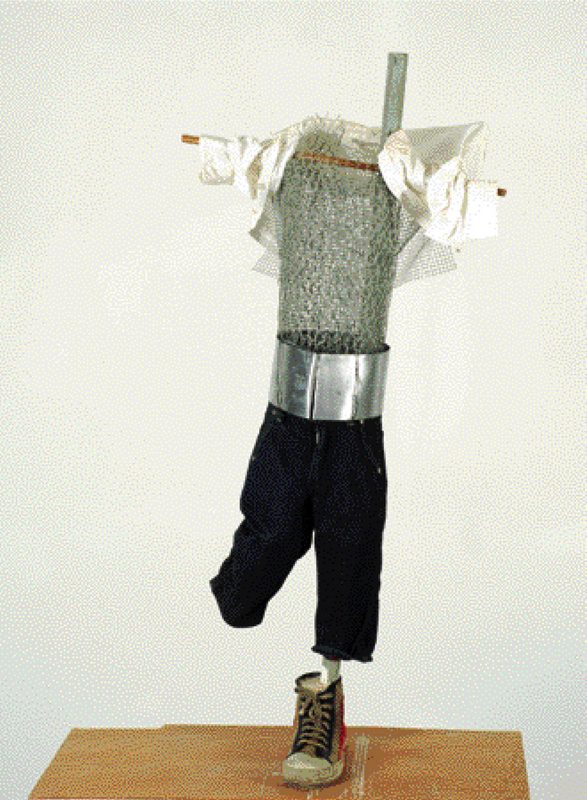TRACES:Vlassis Caniaris
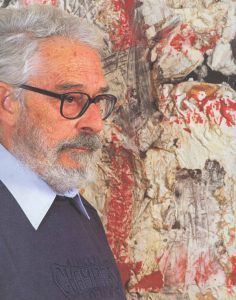 The column, “Traces”, is published as a tribute to artists, living and dead, who have left their mark in Contemporary Art. Through texts or interviews, starting from: moments and memories, we unfold the unknown sides of the great personalities, who have left their traces permanent in time and history… On the occasion of the group exhibition at the ESIEA (Journalists Union of Athens Daily Newspapers), for the celebration of its 100 years, we present an interview with one of the most important artists of the generation of 60s, Vlassi Caniaris. We met in September 2004, on the occasion his exhibition “Exercises” at the Zina Athanasiadou Gallery and talked about his work. This interview has not been published that time, for insignificant reasons, it often happens, however, I had the great fortune to get into my luggage, a valuable document, closing a cycle of artists of his generation, with strong personalities, different searches and concerns, international career and momentous artwork. Vlassis Caniaris is completely gentle, incredibly sensitive, low profile, very bashful and not at all estet. Really great artist, with concentrated thought and speech, hard thinker and accurate as his initial studies in Medicine. His artworks are a psychogram, in space and time, composing the puzzle of the sociopolitical situation of Europe and Greece from the dictatorship and then. Today (?) More topical than ever (!)
The column, “Traces”, is published as a tribute to artists, living and dead, who have left their mark in Contemporary Art. Through texts or interviews, starting from: moments and memories, we unfold the unknown sides of the great personalities, who have left their traces permanent in time and history… On the occasion of the group exhibition at the ESIEA (Journalists Union of Athens Daily Newspapers), for the celebration of its 100 years, we present an interview with one of the most important artists of the generation of 60s, Vlassi Caniaris. We met in September 2004, on the occasion his exhibition “Exercises” at the Zina Athanasiadou Gallery and talked about his work. This interview has not been published that time, for insignificant reasons, it often happens, however, I had the great fortune to get into my luggage, a valuable document, closing a cycle of artists of his generation, with strong personalities, different searches and concerns, international career and momentous artwork. Vlassis Caniaris is completely gentle, incredibly sensitive, low profile, very bashful and not at all estet. Really great artist, with concentrated thought and speech, hard thinker and accurate as his initial studies in Medicine. His artworks are a psychogram, in space and time, composing the puzzle of the sociopolitical situation of Europe and Greece from the dictatorship and then. Today (?) More topical than ever (!)
By Efi Michalarou
Photo: Zina Athanasiadou Gallery
I know that right now, are presented artworks that have not exhibited again, how you decided this?
Ι rediscovered them now, I had abandoned them because of the onsets the Albanians and found them most anti-kap because everything is old of the period ’69 -’70, tested by me, now must be tested and by the public. With this logic, they have not been exhibited, so in cold blood they can be exhibited. Are the works that were made at a time, in a phase of work that was taking different forms and was more complete, I was working the summer, when I was coming to Greece for a month or so, and have a form of essays. For that reason we decided to call them “Exercises”, most found this way’s like someone discovers an old treasure.
Looking at these artworks and your previous work, do you feel that there are some that you do not like, they don’t represent you and you reject them?
No, no! There are certainly works that do not have the same durability in time as others, this does not mean that I will eventually start the burning and the sorting out. With the full sense of the term of destruction and sorting out. I do not understand the burning of certain periods or certain artworks. Eventually, the same person has made all. Hence, the good and the bad are its own. With this logic, I do not understand, why solely exhibit the good ones? It’s like the reviews that a number of artists put in the catalogues, they use only some good phrases and cut all the rest, is not my custom, is not me. I leave the fact, you know, some works when made, the artist thinks that are second-class and after twenty to thirty years, he discovers that he was wrong.
Helps the time distance from the artwork?
Is good, are always to be tested by their creator. It does not hurt. Now I’m against in the logic of the younger artists, they want immediately, to exhibit or to be networked and go from production to consumption. We are a little older, other faculty, the artworks remained at the workshop, passed years there were not these features and amenities so when we decided to exhibit them, they had been tested and had received the final approval.
Do you think this is better?
Other possibilities offers our time and other that era.
How does anyone makes career, through specific moves or through his work? Precedes the work?
Because we were abroad we were late, we were kids, possibly the foreign colleagues in Europe have faced this issue of career much earlier. The meaning of career, we haven’t realize the career, either this was right or wrong, we came from the Greek climate, in which this meaning, did not exist and could not exist.
Why?
The background. Now as in all things, and this has come in the life of younger and they do it. Certainly, there are objective truths, the career in the sense that shuffled and third people, helps to make career, but the best credential is the work. From this point on, there are tactics, where you do what suits you the most, I do not know, I cannot say that I know this scenario so well, because it did not bothered me much. When created this logic of the career, I was already old enough, but I need such operations in practical things. In the organizational that are present in every profession.
Are there people that help?
Of course, as there are artists who do it all, and are managers of themselves, others are not. In a sense, this is part of a talent.
Your Initial Studies before the School of Fine Arts has been in Medicine, how affected your work the human figure?
To this did not influenced me, what affected me and I realized it over the years, is discipline and a control of the logic of the artist with the cape and long hair (laughs). Anyway I never liked medicine, but from the experience of the University, the studying and the contact with my wife who is a doctor, there was a control and an assessment of what is ultimately important and worth mentioning, not the work in itself, but as an investment, so it helped me to be more structured. To be simple, and that was good, I realized that much later. At first I thought they were lost years, were in a sense, on the other the experience I had in my whole life, was very great.
What it was that made you to pass in Fine Arts?
Nothing special, my father wished to become a doctor, I wanted to be a painter, this happens in many families. Thus are the good, the bad.
You started from painting … from the canvas.
By Studying Medicine I and my wife, when we graduated, we decided to leave abroad. For a while in the beginning, but we stuck, I do not regret.
You were in different cities, as we know.
In Rome, Paris, Berlin…
It was very important, at the moment that you were at the Metropolitan centers.
There is no doubt. The atmosphere, however, all life, is the one that guides you. To think, I’ll do so and so is a little sketchy and I do not think, at least to me, that worked. There were things that concerned me and they were not so differently from those that concerned me in Greece. Because certainly, there is a thread that connects all this relationship, the interest in politics…
On the social issues.
In Paris it was different, but even there they concerned me. Now if they logically coincided with searches of other people and that happens. It is extremely confusing and difficult things (laughs), it is not that simple to say. Does not follow, sees this and do it and this denotes a work process and a work, for me like of other people their own persistence, compared with a form which must be yours. Otherwise, there will be thereby between them.
Everyone has his own identity.
Not just that, but in any case, everyone must struggle with his own weapons. With much stubbornness and sacrifice, but in this sense, I can not say that I’m unhappy with my own path. I’m not saying I did a miracle, but for me, I wanted to do, what I did. Moreover, to get back to the previous, the non-contact with this so-called career and consumption, which binds you to and forces you to follow her, has its good and its bad, to be honest, but on the other hand, allowed me to do what I wanted to do. Moreover, to turn to the earlier words, the non-contact with the so-called career and consumption, which is binding and forces you to follow it, has its good and its bad, to be honest, but then allowed me to do what I want to do. I was not accountable to anyone, at any merchant, it certainly has its consequences (laughs). I do not regret!!!
I put it as a question consciously, just because the artist has the freedom to do what he wants and I think when you, do what you want to dio, it can not be baad unless you are very ignorant, or a very bad artist. You belong to a generation of ’60s , as we often say in Greece, which almost all worked abroad.
Not all, those who left what we achieved? To chase the adventure. I must say that we had a confidence in ourselves. To tell the truth, do not start this way. We had to be tested and we were tested as far as we could. However, it is worth for a student, if he wanted, to do a work, to write about the Galleries. To make an investigation, in which Galleries and what were those Galleries, that exhibited this generation. Who exhibited and let us limit it to one year, the year that each of us exhibited. It would not hurt. To realize that this creep in, which was in such a difficult field, was of great importance. It was not just a name.
I wanted to ask you, how important was that? It was not as easy as we think. I imagine how difficult it was that era.
There was not just a name and a Gallery. Look is difficult, but I do not like this characterization, because difficult means you achieve something you do not deserve. Neither for us, the doors opened, just we thought that we fitted there. It was obvious that we would go where we lived.
How many differences are visible in Greece, in relation to the course of events?
Visual arts, you know, slowly have dispersed. There have been not major surprises, nor are large movements. When we talk about the generation of ’60s, we limit this generation in 5-6 painters relating to Greece. This generation relates to a whole world of artists: in music, in theater, in writing or in art, is a much broader thing, the importance of this generation is that it was facing and fighting against the establishment of that era, and was winning, it was not simple, over the years, you end up and choose who are talented. Pierre Restany, with the new realists, had some good artists, but that chose us to go to Venice in ’64, three Greeks, when there were thousands of good artists who had the potential, not only from France, but…
You, Nikos (Kessanlis) and Danil.
From all over the world to choose us and make a suggestion, that means that we deserved it. Now, of course, within the context of a season, this exhibition is more important for them, which they could not imagine being in that position. For us, it was in a context were made certain things that might have been better than we might. It was, as they say in sports that you are in the final eight. By this logic, we first went. All this notorious ’60s we say, it was one attitude, and not only about our attitude towards life, artwork, what we saw, what we did, this was a transformation taking place in Europe. Do not forget France came out of the war in Algeria, it was after Vietnam, it was a whole story is not so simple. Everyone in his own way. Another was concerned more, like me, another less and more the form of the work, the possibilities you had to evolve and do what you want to do. Like and the foreign colleagues, equally good and great.
Do you want to go back and talk about Greece again?
Things anyway, here, are about thirty years back. This is about the limit. Thus, in Greece, I re-lived, what I had somehow lived the period of 60s in Paris where there was the same logic of cover-up, a worthy injustice, misery, to place storefronts shiny… and all the other hidden below. This was the logic of all the artworks of ‘60-’61-62, rags. I’m thinking to begin to do the same things again (laughs), but unfortunately it’s just the same thing. This was happening. Now everything altered, ceased to exist this interest about politics, which was much more intense then and we are in a different period, which will show where things are going…
I have read in one of your catalogues, a phrase that says, “The work of Vlassis Caniaris, is changing about every decade”, Do you agree with this quote?
I do not know if is changing … It is true that until recent years, I exhibited every ten years. Maybe for that reason is linked. I did not had a gallery, now with Zina Athanasiadou, we agree.
Morphological and Thematically, is your work changing every ten years?
There is a thematic that concerns me. This is a processing, a body of work. It takes a lot of time…
Essentially it is research.
The things look almost the same. They are not different
There are times that some artworks externally resemble the same, internally have been many changes, this usually does not relates to the homogeneity of the image.
At least the last thirty-five years since 1970, I deal with the issue of immigrants it took me almost ten years. Beyond that, I did this exhibition in E.M.S.T. (FIX) and again I had something similar, it was Greece through what I saw. I brought the message Greece, but things were not different. These specific topics concern me.
I think there is a common conceptual axis joining an artist’s work and its different periods. Moreover, sometimes it does not matter neither the medium nor the way it communicates, what he wants to express. This is the basis, there is also a body of work.
Even the quote “Whatever the people wants”, is not different than gypsum* made by the junta. Then, this is obsession.
*(In 1967 the military dictatorship of Greece, parallel Greece with a patient who had a broken leg)
I believe the best thing for a human, especially an artist, is obsession. Because if someone has not obsessions how he will advance? After all, your obsession is a social and political issue. In addition, here plays a critical role the identity of the artist and his work.
Is another process, now that I’ve grown up a lot, we enter into a process to be considered are discussed, all academic, to appreciate it, to appreciate me and all of this but once I mentioned this attitude reminds me: I like her aa woman, but I’m not getting married (laughs)
Laughs
So somehow is … (laughs). I must say that this has changed much in recent years. I do not deny and slowly, but anyway, they are interesting… no one can have everything. The self-examination, however, about the art, this is the interesting, concerns me and concerns, everyone that could transmit it and excite them, their own path also. Regardless from my own work.
Can we move on to a specific period of artworks relating to the period of Dictatorship? As they are critical.
It was an exhibition, like a resistance act. With my own means and my potentials, so it worked very pathological and in cold blood and I found that one can be draught. Not to conscript, to draught for a certain period and do targeted acts. Like someone, that paints portraits. It is indeed a specific period. Prevailed a little more in Paris for two years, from ’71 and later I turned emotionally, to the processing of the Greek Immigrant. Where resulted the gesture and after I completed it. That shows that this exhibition of ’69 worked, that time in Greece everyone talked about Gaitis…
I mentioned this exhibition for that reason.
If you ignore all these formal and non-artistic programs, because there was censorship, we did not make a catalog and no text was written. Rather than catalog, I would give everyone who came, the tile with the clove. With the logic that although it is plaster, blinds
Basically this is a-censorship.
It was touching, the acceptance.
After comes the series “Immigrants”, how concerned you? You were feeling that you were an immigrant?
In a way I was. Does not mean that everyone is in the same category. Whether social or economic… now have changed a lot, those things. If I do a similar work now, these terms have been altered. What could negotiate someone and try to make them images and artworks is very different.
If you were asked today to deal with “Immigrants”, How would you express?
I do not know. Because now, things have changed, I have changed too. The Immigrant, who is now in Greece, has no connection with the Immigrants who were that time in Germany, France or anywhere else. Previously existed an emotional charge, conditions were of different kind, now I do not know how it has worked for the state this uncontrolled Immigrant flow. I cannot see the goal, I knew that I had read and I had processed that era, that when the percentage of immigrants, passed 8-9%, problems arise immediately. Whether racial or conflicts. This universal truth and is not questionable. It was very different the way in which the reception was done. It was a controlled situation, something that does not exist today. If one wants to really deal, he should make a lot of work.
It is very important to see the differences of Greek Immigrants in Central Europe with the immigrants flowing in Greece, I found myself 2001 in Tirana Biennale, I am one of the two journalists who were invited…
What, they had organized Biennale at Tirana?
Alternative, curated by Giancarlo Politi, the director of Flash Art and I went there immediately after the Venice Biennale, is of great interest to see and examine the Albanians in their country, it changed my mind, I began to realize that the social context in which someone belongs, is determinant.
We were the same, when the people left their villages and went to Europe. The issue is complex and the next step I wanted to do, is a connection by taking a local group in Germany, in France, with a corresponding group in Greece. I did not do it, because I scared, with what was happening and what I discovered again, so I ended with the series “Other Greece”.
This title was a bit sarcastic, but very realistic.
For me!
In the catalog I have in my hands, I see artworks from different periods, why are all-together? Do you think that you have composed a new unity with all this?
It is an anthology. A gallery has its good and its bad, it does not follow that it is the best solution. They are: Allusions – Exercises. Nothing more and nothing less.
Thank you very much(!)
First Publication: www.dreamideamachine.com
© Interview – Efi Michalarou
